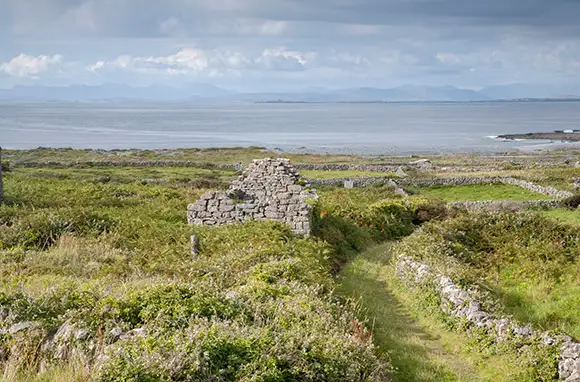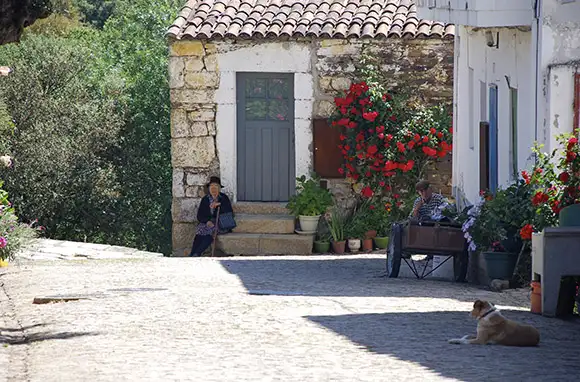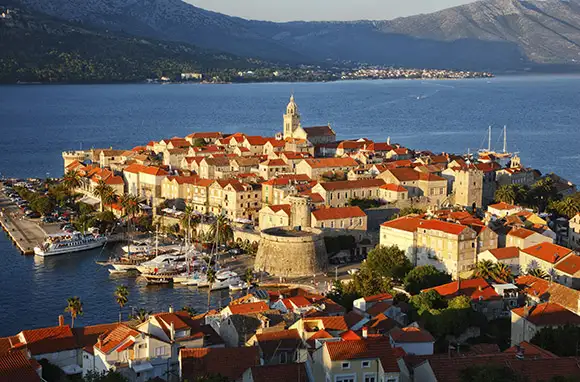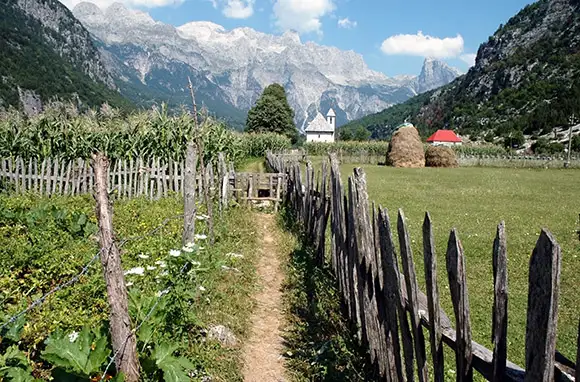If you’ve ever wished you could flip a switch and slow down the world, you’re in luck. “Old Europe” is alive and well in these 10 destinations, all steadfast holdouts of the simple, unhurried life. Here’s where to find small villages, barely explored countries, and untouristed gems—the sorts of places where you’re likely to see more sheep than smartphones.
Image Gallery

St. Sigmund-Praxmar, Valley of Sellrain, Austria
About a 30-minute drive from Innsbruck, the Valley of Sellrain is an unspoiled landscape dotted with mountain villages that have managed to preserve their authentic, rural character. Untouched by commercialism, clusters of traditional Tyrolean chalets are tucked between alpine meadows and rugged mountain slopes. In St. Sigmund-Praxmar (population: 170), there isn't a single shop, bank, or post office. The area is part of a "quiet zone" that for the last 30 years has been protected by the Austrian Alpine Club's strong sense of environmental awareness and motto: "Movement under your own steam." Here mountains are still climbed in the traditional way, without lifts or cable cars. Hikers can follow an extensive network of hut-to-hut trails; or ski and snowshoe pristine, undeveloped areas.

St. Sigmund-Praxmar, Valley of Sellrain, Austria
About a 30-minute drive from Innsbruck, the Valley of Sellrain is an unspoiled landscape dotted with mountain villages that have managed to preserve their authentic, rural character. Untouched by commercialism, clusters of traditional Tyrolean chalets are tucked between alpine meadows and rugged mountain slopes. In St. Sigmund-Praxmar (population: 170), there isn't a single shop, bank, or post office. The area is part of a "quiet zone" that for the last 30 years has been protected by the Austrian Alpine Club's strong sense of environmental awareness and motto: "Movement under your own steam." Here mountains are still climbed in the traditional way, without lifts or cable cars. Hikers can follow an extensive network of hut-to-hut trails; or ski and snowshoe pristine, undeveloped areas.

Canillas de Aceituno, Andalusia, Spain
A small, whitewashed village at the edge of Andalucia's Sierra Nevada mountain range, Canillas de Aceituno was settled 3,000 years ago by the Phoenicians. The original settlers brought with them olive and grape cultivation, and today the majority of residents still make a meager living from these crops. It really is a trip back in time—farming is mostly done by hand with mules pulling the plows, locals often have to pause as goats cross the road, and the local Andaluz dialect of Spanish is unintelligible even to many Spaniards. "Though the village is only about a 30-minute drive from the coast, many of the older inhabitants have still never been to the sea," says Alan Hazel, a local and owner of the Cortijo El Carligto villa. Wander the winding cobblestone streets and hidden alleyways to see Islamic-influenced arches and Moorish motifs from an earlier era. This is one of the villages on the Mudejar Route.

Aran Islands, Ireland
A 40-minute ferry ride from Rossaveel just outside Galway on Ireland's west coast transports you to the Aran Islands, one of the last sanctuaries of traditional Irish life. Vast stretches of farmland, sectioned off by ancient stone walls and ruins of 3,000-year-old Bronze Age stone forts, are reminders of the islands' rich history. Gaelic is still spoken here, and many residents get around by walking or cycling down the narrow grassy lanes. At the end of each day, fishermen on the two smaller islands return to isolated fishing villages in their traditional Curah boats with the day's catch. Lively pubs bring together this strong-knit community of islanders, who gather for nightly dancing and performances of traditional, unaccompanied Sean Nos songs.

Idanha-a-Velha, Portugal
This tiny hamlet of 150 residents at the remote eastern edge of Portugal may be the country's most fascinating place that has hardly been written about. Once an important Roman City with its own garrison, Idanha-a-Velha (then called Egitanea) was home to 200,000 people in the first century. It was so prominent that it became a diocesan seat in 599 AD and had its own bishop for 600 years. In its prime, the city erected a cathedral, baptistery, and bishop's palace. It even had a center to coin gold. Then the empire collapsed. Chaos followed as the doomed city changed hands from Muslims to Christians to Knights Templar, never returning to its former glory. You can still see evidence of each of these civilizations today. Ruins and marked landmarks make Idanha a national monument today, though few have heard of it.

Garfagnana, Tuscany, Italy
In a river valley hemmed by parallel mountain ranges (the Alpi Apuane and Apennines) this isolated region of northwest Tuscany feels cut off from the rest of the world. Cobblestoned pedestrian-only streets meander through many of Garfagnana's small hilltop villages. Farmers and artisans, some of whom have never travelled farther than the next village, carry on age-old family traditions to produce pecorino cheese and chestnut flower honey. Although they're producing renowned Tuscan specialties, many of these locals don't have cell phones, web sites, or even signs on their farms, says Erica Jarman, director of Sapori & Saperi Adventures, a local gastronomic tour operator. This place that time forgot is only an hour from Pisa and 90 minutes from Florence.

Reine, Lofoten Islands, Norway
In the frigid waters of the Norwegian Sea, far above the Arctic Circle, sits a tiny fishing village where hardy locals have weathered harsh conditions for generations, and refuse to leave. Summer in Reine (population: 300) brings the midnight sun, while winter heralds the return of abundant spawning cod stocks. Even today, you'll see hundreds of fish hanging outside in the wind on traditional wooden drying racks every March and April. All done by hand, the grading and drying processes that have been passed down here since the age of the Vikings have made Norway famous for its premium quality stockfish (dried cod). Visitors can stay in a rorbu, the old fishermen's cabins, and cook their own catch of the day.

Viscri, Transylvania, Romania
This traditional Saxon village in Transylvania is one of Europe's best-preserved medieval towns. Built and inhabited by Germans who immigrated here in the 1100s, Viscri was all but deserted in 1989 after communism collapsed and Germany's foreign minister invited Eastern Europe's German-speaking population to return to the homeland. Only a few families stayed behind in Viscri. But, with the help of a foundation, a trust, and an investment by Britain's Prince Charles, the village and its heritage were saved. A visit to Viscri takes you back hundreds of years to an place where shepherds tend their flocks, a village blacksmith forges horseshoes, horse-drawn carts ramble along dirt roads, and the 12th-century Viscri Fortified Church still stands protectively over the town.

Korcula, Korcula Island, Croatia
Just off the Dalmation Coast near Dubrovnik, the medieval walled city of Korcula hasn't completely escaped the reaches of tourism—but Old Europe is certainly alive and well here. This traditional blue-collar shipbuilding and fishing town has deep roots in tradition. Korculans are skilled, respected seamen, and most of the island's traditional songs are about them (and their sweethearts). Such a part of local lives is the sea that even the main ceiling of the city's St. Mark's Cathedral was constructed in a shape reminiscent of a boat. Religious ties are also strong here: Three brotherhoods (the oldest dating to 1301) are prominent social groups that still lead processionals through town. And these winding streets flanked with medieval stone fortresses and terracotta-roofed buildings set a picturesque backdrop for the mock sword battle dances that have been performed here since the 17th century.

Thethi, Albania
At the northern edge of Albania, in what locals call the Albanian Alps, a dirt road snakes between unforgiving peaks before finally arriving at the tiny remote village of Thethi. You'll need to rent a 4x4 or hire a trekking guide to get here. This country, one of Europe's last frontiers, spent 100 isolated years under the thumb of communist rule. Little has changed in Thethi since that era ended. Residents still live in traditional stone houses with wood-shingled roofs characteristic of the rural Albanian north. And the stone "lock-in" tower, which once sheltered people in times of blood feud, remains unchanged. Never under Ottoman jurisdiction, this area developed its own set of traditional laws and passed them down from one generation to another. Most are still observed today.

Ginuciai, Lithuania
Time stands still in the village of Ginuciai, an hour-and-a-half drive from Lithuania's capital city. Home to medieval castles, untouched forests, and old-world tradition, this 16th-century village sits on a lakeshore in Aukstaitija National Park. According to the last census, only 69 people live here. Ginuciai once enjoyed fame for its 19th-century technical engineering feat that produced the village's electricity: a wooden water mill with a water wheel, millstone, and sack uplift mechanism. The mill is still operational today and now also houses a museum and hotel. In the past, the mill was known as a place for mischief of devils, says Kestas Lukoskinas, a Lithuanian tour guide for Intrepid Travel. "Legends say some nights the devils would tear bags with flour and ride away on farmer's horses," he says. Displays and artwork by local artists depict this and other folklore of the region.
More from SmarterTravel:
- 10 Best Hidden Places in Ireland
- 10 Dream Trips You Can Actually Afford in 2016
- 10 Villages You’ll Fall in Love With
Jamie Moore is a regular contributor to Smarter Travel. Her articles have appeared in USA Today, Yahoo Travel, Huffington Post, WestJet magazine, BBC Travel, and others. Follow her on Twitter @jmemoore.
We hand-pick everything we recommend and select items through testing and reviews. Some products are sent to us free of charge with no incentive to offer a favorable review. We offer our unbiased opinions and do not accept compensation to review products. All items are in stock and prices are accurate at the time of publication. If you buy something through our links, we may earn a commission.
Related
Top Fares From
Today's Top Travel Deals
Brought to you by ShermansTravel
France: 8-Night Paris, Avignon & Nice...
Infinity Worldwide Vacations
 vacation
$2880+
vacation
$2880+
Poconos: 3 Nts in Garden of...
ResortsAndLodges.com
 hotel
$305+
hotel
$305+
7-Nt Canada & New England Cruise,...
Princess Cruises
 cruise
$839+
cruise
$839+




